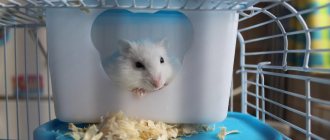You can often see children in a pet store looking at hamsters in fascination. For these little bundles of happiness. And after some time, many of the rodents end up in our families. Why is it worth pouring a little food and enjoying the game? All the time the animal receives the best, but vacation time comes. If you can take a dog with you to the sea or a camp site, then the little ball of fur is in no way inclined to make a long trip. And here many people ask the question: “How long can a hamster live without water?” if left at home.
How long can a hamster live without food and water?
The hamster is a favorite pet of many adults and children. A cute little bundle can bring a lot of happiness to your home. It does not require complex care and a lot of time.
There are situations in life when a family needs to leave home. For example, go on vacation to the seashore. It is not possible to take a small pet long distance. There are several questions that owners ask themselves. How long can a hamster live without food? How to prepare housing for departure?
It is better not to experiment on animals. No one has tested it, and it is impossible to answer for sure, but several theoretical analyzes have been carried out.
Ideally, rodents need to change their food and water daily. But many owners throw out food and add new food once every few days. This is not scary and will not affect the hamster’s condition in any way. Therefore, you can leave the hamster for 3 days. If you need to leave for a whole week, then you shouldn’t risk his life and it’s better to give your pet and house to friends or relatives.
If this option is not suitable, you need to carefully prepare for a long departure. The rodent will not be bored if there are toys in the cage. And he cannot live without food and liquid.
Article on the topic: Why the hamster does not sleep in the house or does not leave it, how to calm the hamster at night
There are certain rules for preparing your home:
- Be sure to do a complete cleaning and throw out everything unnecessary from the cage, pour a thick layer of new filler. Hamsters have a special place where they hide food. These reserves should not be touched; this will lead to great stress. Before departure you must:
- Pour food into the feeder.
- Hide enough food in different places. This way the animal will definitely not remain hungry. When the food in the feeder runs out, he will look for it in the cage.
- Only dry food should be left. Chicken, fruits and vegetables will quickly spoil without refrigeration.
- You can only leave a small piece of raw carrots. They do not spoil for a long time and in the first two days the rodent will definitely eat it.
- Hamsters cannot starve, so it is better to leave food in reserve.
- Be sure to fill the drinking bowl full of water. It is better to buy an additional drinking bowl, so the rodent will definitely not be left without vital fluid.
At what age is it better to buy
This is a very important question. How much joy and positivity the rodent will bring you depends on how correct the answer you find to it depends.
At the same time, it is not advisable to take hamsters older than 1 year. These are already older individuals - they move little and sleep more. Of course, for a child, watching the house in which his pet sleeps will not bring too much joy.
As for the rest, you must decide for yourself. But most breeders try to buy young rodents - they are cheerful, active and playful. Plus, thanks to their youth, they will spend more time with you. But for fast-living hamsters, every month is a whole era.
Does a hamster need water?
Hamsters can only live without water for 2-3 days. It all depends on the species. If your pet goes without fluid for seven days, dehydration and various illnesses may occur. It’s better to play it safe and leave your pet as much water as possible. An additional drinking bowl is very inexpensive, and you can buy it at any pet store.
To understand exactly how long a rodent can live without water, you need to consider:
The hamster loves to drink clean water and may refuse it on the second or third day.
There is a special drinking bowl that is mounted on the wall. A thin tube is stretched out of it. When the rodent wants to drink, it is enough for him to lick his thin nose. Water will flow out of it. This way the liquid does not spill and retains its beneficial properties longer. Hamsters are very smart and always find water in the nipple drinker.
Article on the topic: Walking ball for a hamster: purpose, selection and use (photo)
How long can a rodent live without water? From three to seven days. But it’s better not to check, but to take care of proper care for your beloved pet. Such experiments can negatively affect the health of the hamster.
Failure to study the main signs and symptoms of diseases
It is imperative to know the symptoms of certain diseases. After all, prevention is the best treatment. A timely visit to the veterinarian can save your pet and help avoid many problems.
It is worth paying attention to changes in the behavior of your furry pet. Reasons for concern may include:
- excessive activity and lack of sleep;
- lethargy;
- lack of appetite;
- sadness.
If you find this, be sure to contact a specialist.
How long can a hamster live without food and water? Is it possible to leave him alone at home?
A loving owner will not check how many days a hamster can live without food and water at home. Such an experiment would be inhumane, so there is no exact data on the endurance of the body of small rodents. But the question still worries hamster owners if they need to leave and have no one to leave their pet with.
Rodents are advised to change water and food daily, but many leave their pet alone for 2-3 days without fear for its health. Is it possible to leave a hamster alone for a week? It’s not worth it, it’s a risk to the hamster’s life . When leaving for a long time, it is better to find someone who can visit the animal. An accident can happen even in a cage (its paw gets caught on a wheel, it gnaws through the drinking bowl).
If this is not possible, before leaving you need to create all the conditions for your pet to survive. A hamster is a solitary animal; in a spacious cage with a wheel, it will not be very bored. But food and water are vital for him.
- Give the cage a thorough cleaning and add a good layer of fresh litter.
- Hide food in different corners of the cage, and also fill the feeder full. The amount of food should be sufficient (calculated based on the weight of the animal - 80% of the hamster’s weight per day).
Only dry food and seeds are left; juicy and protein foods are excluded due to the risk of food spoilage.
- You can leave a piece of apple or carrot, which the hamster will eat on the first day. It is very important to provide a small rodent with provisions - hamsters have an intense metabolism, and starvation is contraindicated for them.
- Fill the drinking bowl with fresh water to the top. Provided that the rodent is large and the drinking bowl is small, you need to buy a second drinking bowl.
- A Syrian hamster can drink up to 25 ml per day. The Djungarian drinks much less (2-7 ml), but the Djungarian will not last long without water. The second drinker is a safety net in case the ball gets stuck in the first one, or the mechanism breaks, and all the water spills onto the litter.
Article on the topic: Sand for bathing hamsters: organizing a sand bath
Such situations are rare, but according to the law, meanness happens when no one is at home. If the drinking bowl is faulty, the pet will have a hard time. How long a hamster can live without water depends on the temperature in the room and the characteristics of the body. Provided that the animal eats only dry food - no more than 2-3 days .
It is a mistake to believe that without food and water, a hamster will simply hibernate and wait out difficult times.
A hungry animal can actually go into energy saving mode. But such numbness does not last long.
A hamster is not a bear; even in nature, during hibernation, it wakes up to feed on its reserves. A rodent does not have the ability to survive for a long time on fat deposits. If you don’t treat your baby with a nutritious treat after waking up, he will die from exhaustion and dehydration.
Using the wrong bedding
In order for a hamster to feel comfortable and please its owners with its healthy appearance and active games, it needs to choose the right food, change the water often and use the right litter for the cage.
You can find a lot of bad advice on numerous forums on the Internet. For example, that rodents love rags. Bury yourself in them and live there. However, this is not at all true. The rags will quickly absorb dirt and become unhygienic. Besides the fact that it will emit an unpleasant odor, and aromas are important for hamsters.
How to find out the age of a Djungarian hamster
There are several parameters, based on which you can more or less accurately determine the age of the animal that interests you. This is necessary, first of all, so that you are not deceived during the purchasing process by unscrupulous sellers, because if you buy an old hamster, you will get completely different indicators of activity, satisfaction with what is happening and life expectancy.
Let’s immediately make a reservation that it is difficult to find out exactly the age of a hamster even for specialists, so all divisions will be purely conditional - into old and young. Here are a few basic parameters, based on which you can roughly understand the age of the hamster:
- behavior: a young animal is always more active, while an old one prefers rest and tranquility. Old hamsters eat less, hardly leave their hiding places in cages, and almost never explore the world around them;
- hair on the ears: young hamsters have a magnificent, pleasant-to-touch white hair in the ear area, while older hamsters often have virtually no hair;
- eyes: if you see that the animal’s eyes are cloudy, cloudy or whitish, then this hamster is either old or sick. In any case, you shouldn't buy yourself like that;
- weight: perhaps the most reliable of all the previous parameters. If you weigh a young hamster up to 3 months old, its weight will not exceed 40 g, while older individuals weigh an order of magnitude more.
Signs of aging hamster: video
Amount of food
How much food a hamster needs per day depends on many factors:
- physical activity;
- age (young animals eat much more);
- physiological state (pregnancy, lactation);
- room temperature.
The average rodent eats an amount of food per day equal to 70% of its body weight.
A Syrian hamster weighing 140-150 g should receive about 100 g of food.
Such accuracy of calculations is not used in practice, and the owner can only approximately say how much a hamster eats per day.
The Djungarian hamster or Campbell is so small that it seems to the owners that they are eating “closely.”
It is a big mistake to overfeed your pet. Hamsters get fat easily.
From the outside it may look cute, but the animal itself faces serious health problems and shortens its life. If a dwarf has already received a tablespoon of dry food, and the feeder is instantly empty, you should not fill it again. The pet simply hid food around the cage.
To what age do they grow?
Hamsters are born surprisingly tiny - about the size of a bean and weighing no more than 3-4 grams. Surprisingly, they not only survive, but, with an abundance of mother's milk, begin to grow quite quickly.
It is simply impossible to say unambiguously how long they take to grow. The fact is that it depends primarily on the breed.
In the smallest varieties (for example, dzhungariki), the cubs grow for about 1-1.5 months. After this, they continue to grow, but mainly in breadth. That is, by this time they become adults. If you try to determine how old a hamster is by human standards, you can approximate the figure at 16-18 years. Syrian hamsters are larger, which is why they grow 1-2 weeks longer. It's really fascinating to watch the different stages of development. And an experienced specialist, looking at the cub, will be able to quite confidently name its age with an accuracy of several days. Let's talk about this in more detail.
Necessary conditions for a long life of a pet
- In order for your beloved furry to please you for as long as possible, you need to monitor his diet and follow certain care and safety recommendations. We'll talk about this below.
- First you need to reduce the background noise. Rodents do not tolerate loud sounds well, and therefore you should not try to compensate for the lack of games and communication with your hamster using TV or radio.
- Do not leave your pet's cage on a windowsill or in other places where direct sunlight will fall on the hamster.
- Keep the cage clean. It is necessary to remove excrement every 2-3 days and completely change the filler and wash the cage once a week.
- When choosing a home for an animal, give preference to single-story cages or terrariums with a large area. Also, you should not take cages with painted rods, the hamster will chew them and may get poisoned. It is better to give preference to stainless steel rods, which should be located at such a distance that the animal cannot crawl between them. We also recommend buying a cage with a retractable plastic bottom so as not to disturb your pet unnecessarily.
Group keeping of rodents
If you are interested in the question of how long do hamsters live in groups at home? The answer is clear – not for long! Remember that almost all breeds of this domestic animal do not like the proximity of their fellow animals. The only exception is the mating period. In other cases, there is no point in hoping that a family or group of animals will live together for up to three years.
These pets have a special predisposition to injure and destroy each other. Sometimes the injuries are so serious that the animal simply cannot be saved and it dies at an early age.
GOD
- Messages: 15064
- Registered: Wed Dec 01, 2004 00:16
- Profile
- Top
- Report this message
Re: Who has hamsters? Tell.
Super VIP
- Messages: 3289
- Registered: Fri Oct 14, 2005 05:43
- Profile
- Top
- Report this message
Re: Who has hamsters? Tell.
I had a hamster. They left him alone for 3 days with a supply of water and plenty of food. Half a cabbage, a whole apple divided into pieces, bagels, etc. Just as they left and arrived, he didn’t even notice
Super VIP
- Messages: 3233
- Registered: Tue Dec 13, 2005 17:26
- From: from the puppet theater
- Profile
- Top
- Report this message
Quiet, Doll, thank you
I just think that she is still young and stupid. On the first day she will eat everything we leave for her, her stomach will hurt, and then she will starve
People who already know me laugh at me because I treat my hamster like a child, I worry too much
GOD
- Messages: 15064
- Registered: Wed Dec 01, 2004 00:16
- Profile
- Top
- Report this message
Quiet, Doll, thank you
I just think that she is still young and stupid. On the first day she will eat everything we leave for her, her stomach will hurt, and then she will starve
People who already know me laugh at me because I treat my hamster like a child, I worry too much
Before she leaves, try giving her a lot of food and see if she eats it all at once.
Super VIP
- Messages: 3289
- Registered: Fri Oct 14, 2005 05:43
- Profile
- Top
- Report this message
And I rarely give anything fresh. She loves watermelon rinds and celery, but then she gets diarrhea. That’s why I give him dry food, all sorts of seeds, nuts, and vitamins.
A-Lesko, the fact of the matter is that we are going on a hike with friends, there is no one to leave to. There is also a neighbor with whom I say hello, but I just can’t muster up the nerve to ask. Plus, he has a dog, and my hamster once fell into severe depression because of the dog, and for several days she almost didn’t leave the house.
GOD
- Messages: 15064
- Registered: Wed Dec 01, 2004 00:16
- Profile
- Top
- Report this message
I don't know the breed; here she is :
Thanks for the site, I ran off to read it
GOD
- Messages: 15064
- Registered: Wed Dec 01, 2004 00:16
- Profile
- Top
- Report this message
Super VIP
- Messages: 3289
- Registered: Fri Oct 14, 2005 05:43
- Profile
- Top
- Report this message
GOD
- Messages: 15064
- Registered: Wed Dec 01, 2004 00:16
- Profile
- Top
- Report this message
Super VIP
- Messages: 3289
- Registered: Fri Oct 14, 2005 05:43
- Profile
On the same day I lost my apartment keys. At home I went to the store, but couldn’t return. The prospect is “chocolate” - the owners will be gone for 2 weeks, and at least the bells will ring. And all the things in the apartment. everything would be fine, but 2 things were completely depressing: 1. Tomorrow was my birthday. A cafe has been ordered. A party is planned until the morning. New dress and shoes in the apartment, money in the apartment. And I’m wearing sneakers and with change in my wallet. But this too can be survived. 2. And the second one quietly started to make me afraid. Oil painting: after 2 weeks, relaxed owners return from vacation, full of the best impressions. The door opens. And this terrible corpse smell. They still don't understand what happened. And their daughter is eagerly eager to meet her dearest child - the hamster. And within 2 weeks in the heat he won’t just die from dehydration. This bastard will begin to decompose in all its flies and stink in its fragrant manifestations. Howling hysteria and at least a week of airing the wonderful smell.
She went to spend the night with her parents. The issue was resolved with the dress and money, I bought shoes. What about the hamster? what did he give me? Damn birthday present.
Naturally, all thoughts are not about rest and congratulations, but about a dying infection. I never thought that it was possible to wait for someone’s call on your birthday! Hopelessness dot ru. But hallelujah, the hostess called to congratulate. (she had my mobile). I jumped like a shot doe and screamed into the phone, shouting over the music, that I had lost my keys and your hamster was without water for the second day! Words: “I’ll come tomorrow. I’ll bring the keys to work,” seemed magical and life-saving. I can imagine how the hostess swore when she left at 4.30 in the morning from her vacation. By 10 she was at the apartment.
I was given a duplicate key. The hamster was rescued and alive. still alive.
On a sunny summer morning, I walk to work for 5 minutes at most. There's no need to rush. The birthday has passed. The hamster is saved. Life is Beautiful! - Will you get some fresh water? And Khome is already purple - he decided to give up his sinful soul a day later. I don’t remember how many variations of the word “crap” I said this morning. But only one plan matured in my head, and it was the right one: to go to the market for a live “Homa”. I quietly hated him. And when I realized that I would also have to drag his corpse with me to the market in order to choose a more plausible twin brother, I was ready to kill him if he were alive.
10 am, I’m running around the shelves with the corpse of a hamster in my arms, looking for something similar. The sellers are not surprised at me. They have already seen corpses in their lives. Hooray! it has been found more or less. I'm on a trolleybus. They put him on the wanted list at work. She replied that I was going to hide the corpse. The management was humorous and did not ask for details.
And only at the apartment it dawned on me that my Khoma was old, his hair was sticking out in clumps on the back of his neck, but this one was handsome and his hair was long and beautiful. E. what to do, what to do - cut your hair. God, I've never heard hamsters squeal - it's some kind of ultrasound. He struggled, twitched, chewed on me, I thought he would die of a heart attack - he cursed nothing. Well, it's more or less similar. The scruff is safely cut, it will grow in another 2 weeks - everything is ok! The corpse was safely deposited in the abyss of the nearest trash can. You can go to work. The people in the office cried for two hours.
On a sunny summer morning, I walk to work for 5 minutes at most. There's no need to rush. The birthday has passed. The hamster has been purchased. Life is beautiful! So pour some water! Only this beast, after yesterday’s haircut, began to shy away from me around the cage so much that with such stupidity it was possible to break the bars. In short, this one, at first glance, was an imbecile, soared up my hand in the blink of an eye and sank under the sofa. Two hours of searching were unsuccessful. They put him on the wanted list at work. She answered that I was looking for a future corpse - if I found it, I would kill it! The office was crying.
My friends and I turned over all the furniture in the apartment, but after 12 days the hamster was not found. Maybe I'm dead? May he rest in heaven - buy another one and not suffer! No, I’m not dead, such a brute - every night he took the grain from the cage and came to drink. I saw it twice, but couldn’t catch it.
And here is day X. The owners of the house. The hamster was found in the sofa, he pulled out 2 kilos of grains there, a thrifty cheapskate. My daughter really missed the hamster, those happy children’s eyes and the killer phrase: “Mom, he’s become very wild without me, next time we’ll leave, we’ll take him with us.” 3 covenants were “fulfilled” with honor: - Give Khoma water every day; - Don’t add too much food. And as a joke, “If only he doesn’t die, he loses weight, we’ll fatten him up!”; - Don’t let him out (if he runs away, you won’t find him).
Proper keeping of a hamster at home can not only improve the well-being and health of the small rodent, but also prolong its life. If you create all the conditions for a comfortable existence, the hamster will live a long and happy life without stress.
Pros of keeping a hamster
- low cost of a hamster;
- low cost of accessories for maintenance;
- takes up little space;
- does not require special care and knowledge;
- does not make noise;
- no wool;
- no need for daily walks;
- you can keep one hamster, without a pair;
- does not pose a danger to both adults and children;
- easy to breed;
- easy to place the babies.
Disadvantages of keeping a hamster
- they sleep during the day and are active at night;
- unpleasant odor if you do not clean up food debris and excrement daily;
- low life expectancy, from 2 to 3 years;
- some individuals hibernate, depending on the species and conditions of detention.
To keep a pet hamster you will need:
- cell;
- house;
- toys;
- feeders 2 pieces;
- drinking bowl;
- running wheel, ball, maze, playground or tunnel.
When choosing a cage, you need to take into account the number and type of hamsters you plan to keep. It is not recommended to house several hamsters in one cage, but in practice it turns out differently. The minimum cage size for one rodent is 60 by 40 cm. It is important that the bars of the cage are positioned horizontally, since hamsters are very active and love to climb the walls of the cage.
The cage must be selected specifically for small rodents. Since the distance between the rods plays an important role. If you are planning to get dwarf hamsters, choose a distance so that a small hamster cannot fit between them.
To keep hamsters, they often buy a cage. But you can use an aquarium. It is important that the size of the aquarium also corresponds to the minimum size of 60 by 40 cm per pet, and the number of hamsters living.
Under no circumstances should hamsters be kept in cardboard boxes or plastic containers. Hamsters are rodents; their teeth grow throughout their lives. They will instantly chew up a dwelling made of fragile material and run away. Finding and catching an escaped hamster is not an easy task. But besides this, he can also get poisoned.
Choosing a location for the cage
Often owners do not pay attention to where to place the hamster's cage. This is a rather important point, which affects both the health and life expectancy of the animal.
Things to consider when choosing a location for a cage:
- Avoid direct sunlight on the cage;
- avoid bright light;
- limit access to the cage for other animals;
- avoid drafts;
- there should be no temperature changes in the room;
- do not place under air conditioning;
- do not place near heating devices;
- there should be no strong odors or smoke in the room;
- do not place near a TV, radio, or stereo system;
- do not place the cage in a walk-through area;
- Do not place it in a children's playroom, as hamsters are afraid of sharp and loud sounds.
For the cage you need to choose a quiet, non-passable place. The cage should not be moved frequently. The optimal temperature for keeping hamsters is 20-25 degrees.
It is necessary to install a house in the cage so that the hamster can rest during the daytime and feel safe. Also in the cage you need to put 2 feeders and a drinking bowl. Feeders with drinking bowls must be attached to the bars of the cage, otherwise an active animal will definitely turn over and trample the contents. One feeder is needed for the grain mixture, which is the main feed, the other is needed for succulent feed.
It is worth considering that hamsters are very mobile and active animals. They definitely need to buy and install a treadmill, ball, tunnels, and labyrinths in the cage. Special playgrounds for hamsters are sold, which already include the listed attractions, as well as various toys for the hamster.
What do they die from?
In its natural habitat, a hamster will most likely die from malnutrition, too harsh a winter, or in the clutches of a predator. But there are also certain risk factors at home. The most common ones include:
- Insufficient physical activity.
- Chronic or excessive stress.
- Domestic injuries, for example, while walking.
- These or other diseases.
- Overeating, even just once.
Pay special attention to protecting the animal from severe stress. Djungarians have a rather delicate nervous system that is easily damaged. At the same time, it has been scientifically proven that special mechanisms of accelerated aging are triggered.
You can understand that the animal is experiencing stress by the fact that the hamster suddenly fell into a kind of stupor, which does not go away for quite a long time. It may even resemble a prolonged hibernation. In this case, pay attention to the pet’s diet and its emotional background.
It is recommended to carefully wake up the pet, warm it up, and provide it with a comfortable and calm environment that will contribute to its recovery.
No matter how funny your pet is while eating, it is absolutely forbidden to overfeed it! Even a single overeating can lead to the death of the animal.
In the wild, hamsters constantly run around looking for food. Therefore, it is necessary to provide sufficient physical activity to the domestic dwarf. This will minimize the negative consequences of small overeating.
Amount of food
How much a hamster eats per day depends on several factors:
- Age of the pet – youngsters eat more than adults.
- Pregnancy, feeding babies.
- Ambient temperature.
- Rodent activity.
According to statistics, a hamster eats a volume of food per day equal to 70% of its body weight. For example, a Syrian weighing about 150 g should be fed 100 g of food.
As a rule, owners do not make accurate calculations, guided by observations of the pet. Don't feed your Djungarian hamster too much. Overfeeding will lead to obesity and health problems.
It’s funny to look at a fluffy, plump dwarf, but the animal is very uncomfortable with excess weight. Obesity threatens serious diseases and shortens the life of a hamster. Keep an eye on your pet while eating; he may not eat the amount of food intended for him, but may hide some of it.
Bowl or sippy cup?
The daily drinking rate for a healthy rodent is 5-15 ml of water per 100 g of body weight. Using a bowl can cause constant tipping and puddles inside the cage. Litter, feces and food can also spoil the taste of the water if you use the bowl as a reservoir. The optimal solution for the animal is a water bottle.
A drinking bowl attached to the walls of the enclosure saves space and easily trains the animal to drink. When you press the valve or ball at the end of the spout, water drips into the rodent's oral cavity. Most animals determine the source of moisture themselves, but sometimes help is required. Just splash a drop of water on your pet's nose.
Algorithm
The fluffy miracle, seeing the drinking bowl for the first time, does not understand what kind of object it is and what it is intended for. Your task is to introduce him to this useful thing and teach him how to use it. Stick to the following plan:
- Place a water bowl inside or outside the cage. Pay special attention to the height of the spout. The animal must be able to reach it freely.
- Wait a couple of hours and watch the animal, suddenly the hamster becomes interested and touches the ball with its nose. In this case, he himself will understand how to use the drinking bowl.
- If the animal has not shown interest, you will have to train it. To do this, place the hamster near the hole and press the ball with your finger. A droplet will hang on the metal spout. The moisture will remain on your finger; lightly run it over your pet’s nose. After this, you can bring the animal to the tube and lightly touch the ball with its muzzle.
There is another interesting way: you need to lubricate the nose with some yummy food. Khoma, attracted by the pleasant smell, will try to chew the rod, some water will get into his mouth - and he will understand what this thing is for.
Now you know why a hamster doesn't drink water. By following our recommendations, you will quickly accustom your pet to drinking water. The main thing is to remember to change the water in it often.
Source
Other factors
How long a hamster lives at home depends on other factors and living conditions.
Rodent transfer
Try to move your hamster not only from the pet store to your home, but also around the house, as carefully as possible. It is very important that your hamster does not hit his head. A head injury can negatively affect his health and, in the future, his life expectancy.
Content temperature
Sudden temperature changes in the room where the pet is kept do not lead to anything good. Your furry can freeze, get sick and die from a cold. The optimal temperature for keeping a domestic hamster is 18-20 degrees Celsius. If the temperature is lower, the rodent hibernates, thus experiencing another cycle of its life.
Age of acquired rodent
Not everyone can determine the age of a hamster when purchasing. If you end up with an unscrupulous pet store seller, it is possible that you will buy a one-year-old pet or, on the contrary, one that is too young (up to 60 days). As you understand, an old hamster will not live long, but one that is too young, not yet adapted to living independently in a new place, will die without maternal care and warmth.
Diseases
When buying a particular breed, it is very important to pay attention to the animal’s fur. It should be smooth and shiny. The eyes of a healthy animal should not be cloudy, sour or have any injuries.
You can determine whether a hamster has a disease not only by its fur and eyes, but also by its behavior. A sick animal will be lethargic and sleepy. Even by difficulty breathing, you can understand that the rodent is sick with something.
As you understand, a sick animal cannot live longer than a healthy rodent. It is very important to pay attention to all these symptoms, since some diseases of hamsters are dangerous to humans.
Feeding frequency
It's funny to watch the animal eat, but the optimal time is to feed once in the evening when the animal is active. Another acceptable option is feeding in the evening and early morning hours, before the animal naps during the day. The evening portion should be significantly larger than the morning portion.
Having decided on a schedule that is convenient for themselves, it is better for the owner to stick to one feeding time. With amazing accuracy, the animal will wait for dinner at the appointed time. This stability is beneficial for the rodent's digestion.
Due to the high metabolic rate, the hamster cannot tolerate hunger strike at all. It is difficult to answer unequivocally how many times a day a hamster should eat.
Although the main meal occurs at night, the animals like to wake up during the day to have a snack. Therefore, access to food should be available almost around the clock.
When it comes to how often you should feed your hamster, it is important not to overdo it. You cannot give food more than twice a day: this will disturb the animal’s sleep. Juicy and protein foods can spoil if the hamster does not eat it right away. For the same reason, inventories are regularly inspected, removing spoiled products.











